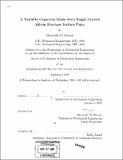A variable capacitor made from single crystal silicon fracture surface pairs
Author(s)
Sprunt, Alexander D. (Alexander Dalziel), 1977-
DownloadFull printable version (39.56Mb)
Other Contributors
Massachusetts Institute of Technology. Dept. of Mechanical Engineering.
Advisor
Alexander H. Slocum.
Terms of use
Metadata
Show full item recordAbstract
Complementary and nano-smooth single-crystal-silicon surfaces have been fabricated by deliberately fracturing a weakened portion of a larger structure whose flexural mechanism refines and concentrates an externally applied load to a notched specimen region pre-.fracture and acts as a precision bearing post-fracture. When material is not ejected, crystalline silicon's extreme brittleness at room temperature results in complementary fracture surfaces; "closed" gaps of 20-30 nanometers are typical. Lithographic, focused ion beam, and anisotropically etched notches as well as crystal orientation and specimen thickness were studied, and a method was developed for fabricating smooth surfaces perpendicular to the wafer plane: 10 micrometer square specimens oriented with the (110) plane are fully notched by anisotropic etching (KOH) and fractured within a structure optimized to apply pure tension. Prototype MEMS variable capacitors employing fracture surfaces as separable parallel plates have been developed. The advantage of fracture surfaces over etched surfaces is their exceptional flatness or complementarity, which allow them to very closely approach each other prior to contact. (cont.) For a parallel-plate capacitor, a small minimum separation disproportionately improves dynamic range because capacitance scales with the inverse of separation. To take utmost advantage of the surfaces' qualities, unstable pull-in must be avoided. Modelling of the three-way force balance between the structure's compliance, the capacitive force between the fracture surfaces, and the zipping electrostatic actuator demonstrates the system is stable when the actuator is working against the spring force and not the capacitive force. The structure and the capacitor are tuned to ensure system stability to nanometer scale separations. During fabrication of the variable capacitor, it was discovered that high temperature processing associated with the thermal oxidation necessary for the actuators blunted the anisotropically etched notches. This blunting occurred even when the notches were covered with a nitride diffusion barrier, and was likely due to diffusional smoothing. Blunt notches produced material ejecting fractures with non-functional surfaces, but since material ejection is characteristic of higher stress fractures, it may be useful for toughening anisotropically etched structures. (cont.) The blunting problem was overcome by masking the notch etch with thermal oxide after all high temperature processing was complete.
Description
Thesis (Ph. D.)--Massachusetts Institute of Technology, Dept. of Mechanical Engineering, 2005. Includes bibliographical references (p. 263-279).
Date issued
2005Department
Massachusetts Institute of Technology. Department of Mechanical EngineeringPublisher
Massachusetts Institute of Technology
Keywords
Mechanical Engineering.